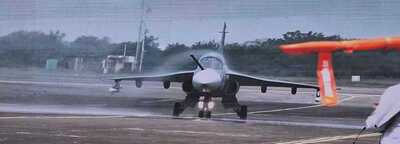NASHIK : The first Tejas-Mk1A fighter aircraft produced at defence PSU Hindustan Aeronautics Limited 's ( HAL ) Nashik complex completed its maiden flight here on Friday. The aircraft was rolled out after defence minister Rajnath Singh formally inaugurated the LCA and HTT-40 (trainer aircraft) assembly complexes here.

The formal induction of Tejas-Mk1A into the Indian Air Force ( IAF ), however, will depend on the successful completion of ongoing weapon and radar integration trials.
Nashik now hosts the third LCA production line and the second HTT-40 production line. The rollout event, which included a traditional water cannon salute for the Mk1A, comes even as HAL races to meet Tejas-Mk1A delivery timelines for the IAF.
The aircraft must clear trials involving the Astra beyond-visual-range air-to-air missile, short-range missiles, and laser-guided bombs.
The pre-induction tests will also validate integration with the Israeli-origin ELTA ELM-2052 radar and fire-control system. Earlier tests had encountered software-related snags, prompting modifications before final validation.
The Mk1A rollout from Nashik is part of HAL’s broader production ramp-up plan. In addition to its two operational lines in Bengaluru, HAL has established a third line at Nashik, designed to produce up to eight aircraft annually.
The PSU has also developed a parallel private-sector supply chain — VEM Technologies (centre fuselage), Alpha (rear fuselage), and L&T (wings) — to support an additional six aircraft each year. Once stabilised, this ecosystem is projected to enable annual production of 30 fighters from 2026-27.
HAL is currently grappling with delays in the delivery of 99 GE F404 engines contracted in Aug 2021 for Rs 5,375 crore. Only four engines have been received so far. GE has assured the supply of eight more engines by March 2026 and around 20 engines per year thereafter. Despite the lag, HAL maintains that it has managed to keep production moving by rotating available engines for test flights.
The initial order for 83 Tejas Mk1A aircraft, cleared in 2021, was to be delivered between 2024 and 2028. In Aug 2025, the Cabinet Committee on Security approved an additional 97 Mk1A fighters for Rs 66,500 crore, taking the total order to 180 aircraft.
Air Chief Marshal AP Singh has repeatedly flagged the urgency of new inductions, saying the IAF is “very badly off in numbers” and needs at least 40 fighters a year to sustain combat readiness. HAL officials have said they are confident of meeting this requirement once the production ecosystem stabilises and integration issues are resolved.
Friday's event also saw a formation flying of the Tejas-Mk1A, HTT-40 and Su30-Mki.
The formal induction of Tejas-Mk1A into the Indian Air Force ( IAF ), however, will depend on the successful completion of ongoing weapon and radar integration trials.
#WATCH | Nashik, Maharashtra | LCA Tejas Mk 1A gets a water cannon salute after its maiden test flight today. https://t.co/HtZiheoppl pic.twitter.com/R5r4BJZ1ym
— ANI (@ANI) October 17, 2025
Nashik now hosts the third LCA production line and the second HTT-40 production line. The rollout event, which included a traditional water cannon salute for the Mk1A, comes even as HAL races to meet Tejas-Mk1A delivery timelines for the IAF.
The aircraft must clear trials involving the Astra beyond-visual-range air-to-air missile, short-range missiles, and laser-guided bombs.
The pre-induction tests will also validate integration with the Israeli-origin ELTA ELM-2052 radar and fire-control system. Earlier tests had encountered software-related snags, prompting modifications before final validation.
The Mk1A rollout from Nashik is part of HAL’s broader production ramp-up plan. In addition to its two operational lines in Bengaluru, HAL has established a third line at Nashik, designed to produce up to eight aircraft annually.
The PSU has also developed a parallel private-sector supply chain — VEM Technologies (centre fuselage), Alpha (rear fuselage), and L&T (wings) — to support an additional six aircraft each year. Once stabilised, this ecosystem is projected to enable annual production of 30 fighters from 2026-27.
HAL is currently grappling with delays in the delivery of 99 GE F404 engines contracted in Aug 2021 for Rs 5,375 crore. Only four engines have been received so far. GE has assured the supply of eight more engines by March 2026 and around 20 engines per year thereafter. Despite the lag, HAL maintains that it has managed to keep production moving by rotating available engines for test flights.
The initial order for 83 Tejas Mk1A aircraft, cleared in 2021, was to be delivered between 2024 and 2028. In Aug 2025, the Cabinet Committee on Security approved an additional 97 Mk1A fighters for Rs 66,500 crore, taking the total order to 180 aircraft.
Air Chief Marshal AP Singh has repeatedly flagged the urgency of new inductions, saying the IAF is “very badly off in numbers” and needs at least 40 fighters a year to sustain combat readiness. HAL officials have said they are confident of meeting this requirement once the production ecosystem stabilises and integration issues are resolved.
Friday's event also saw a formation flying of the Tejas-Mk1A, HTT-40 and Su30-Mki.
You may also like

Three indictments, one exception: Why the case of John Bolton stands apart from that of James Comey and Letitia James

Discharged from hospital, Durgapur rape survivor to stay in state till probe on

Credit Cards - Are you worried about your credit card bill? Learn some tricks to reduce it.

Govardhan Puja 2025: Date, time, rituals, Annakut preparations, and how to invoke Lord Krishna's blessings at home

JioFrames to make market debut in the next few months, RIL executive says






